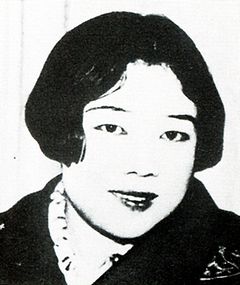- Okamoto Kanoko
-
Okamoto Kanoko 
Okamoto KanokoBorn 1 March 1889
Tokyo JapanDied 18 February 1939 (aged 49)
Yokosuka JapanOccupation Writer Genres novels and poetry Notable work(s) Tsuru wa yamiki
InfluencesIn this Japanese name, the family name is "Okamoto".Okamoto Kanoko (岡本 かの子, 1 March 1889 - 18 February 1939) was the pen-name of a Japanese author, tanka poet, and Buddhism scholar active during the Taishō and early Shōwa periods of Japan.
Contents
Early life
Kanoko's maiden name was Ohnuki Kano. She was born in Aoyama, Akasaka-ku (present day Minato, Tokyo, to an extremely wealthy family. Her father suffered from lung disease, and Kanoko was sent to the Ohnuki family estate in Futako Tamagawa, Kawasaki city, Kanagawa prefecture, where she was raised by a governess. Her tutor encouraged her affinity for music, calligraphy and traditional dance, and introduced her to Japanese classical literature, especially the Genji Monogatari and Kokin Wakashū.
Literary career
Kanoko was influenced greatly by her older brother, Shosen, and his classmate Jun'ichirō Tanizaki who studied at the First Higher School and Tokyo Imperial University. While still a student at the Atami Gakuen girls' high school, Kanoko called on the renowned poet, Yosano Akiko, and this encounter prompted her to start contributing tanka to the poetry magazine Myōjō ("Bright Star"). Later, she played an active part as a key contributor to another journal, Subaru ("Pleiades"). She published Karoki-netami, the first of her five tanka anthologies, in 1912.
In 1908, she met cartoonist Okamoto Ippei while on a holiday in Karuizawa, Nagano together with her father. However, her family was extremely opposed to the relationship, and she created a scandal by moving in together with him in 1910 without marriage. Their eldest son, the famous avant-garde painter Okamoto Tarō, was born the next year. However, Kanoko's family life was filled with tragedy. Soon after she moved in with Okamoto Ippei, her brother, then her mother died. Her eldest daughter was born with mental health problems, and soon died. Her common-law husband was opposed to her independence, jealous of her artistic successes and was unfaithful. Her younger son was also born with weak health, and died in infancy.
These problems led Kanoko to turn to religion. She was first interested in Protestant Christianity, but did not find it to her liking. She then turned to the Jodo Shinshu sect of Buddhism, as espoused by Shinran, which was the start of her work as a researcher of Buddhism, about which she wrote numerous essays.
After releasing her fourth tanka anthology Waga Saishu Kashu ("My Last Anthology") in 1929, she decided to become a novelist. She took her whole family to Europe to complete her literary studies. They traveled to Paris, London, Berlin and (leaving their son behind) toured around the United States, returning to Japan in 1932.
After returning home, Kanoko continued her researches into Buddhism, but also found time to a novelette called Tsuru wa Yamiki ("The Dying Crane"), describing the last days of writer Ryūnosuke Akutagawa, while staying at an inn near Kamakura train station in the summer of 1923. Published in the influential magazine Bungakukai in 1936, it marked the started her activity with prose fiction.
After that, she published many more works in quick succession, including Hahako Jojō ("The Relationship between Mother and Child"), Kingyo Ryōran ("Goldfish Blooming"), and Rogishō ("Portrait of an Old Geisha"). A recurring theme in her work is the effect of a person's familial ancestral karma on their present-day lives. While praised for the richness of her use of language, some critics have felt that she tended towards excessive passion and unnecessary literary flourishes.
Her life was ended prematurely in 1939 when she died of a brain hemorrhage. She was 49 years old.
Because she did not begin writing actively until her later years, most of her works were published posthumously.
Selected works
- Tsuru ha Yamiki (The Dying Crane) (1936)
- Minatsu no Yoru no Yume (A Midsummer Night's Dream) (1937)
- Hahako Jojō (The Relationship between Mother and Child) (1937)
- Kingyo Ryōran (A Riot of Goldfish) (1937)
- Rogishō (Portrait of an Old Geisha) (1938)
- Kawa Akari (Stream of Light) (1938)
- Maru no Uchikuchihanashi (Story of Inside the Grass Circle) (1939)
- Kigi Ryuuten (Lively Ebb and Flow) (1940)
- Nyotai Hiraken (The Opening of the Female Body) (1943)
English Translations:A Riot of Goldfish [Kingyo ryōran]. Translated by J. Keith Vincent. London, Hesperus Press (2010). (Also includes "The Food Demon" [Shokuma])
See also
- Japanese literature
- List of Japanese authors
References
- Sugisaki, Kazuko. 'A Writer's Life: A Biographical Sketch'. In The House Spirit by Okamoto, Kanoko translated by Sugisaki, Kazuko. Capra Press (1995). ISBN 0884963926
- Copeland, Rebecca. The Modern Murasaki: Writing by Women of Meiji Japan. Columbia University Press (2007). ISBN 0231137753
External links
- Kamakura's Literary Figures
- e-texts of works on Aozora Bunko (Japanese)
Categories:- 1889 births
- 1939 deaths
- People from Tokyo
- Japanese women writers
- Japanese poets
- Deaths from cerebral hemorrhage
Wikimedia Foundation. 2010.
